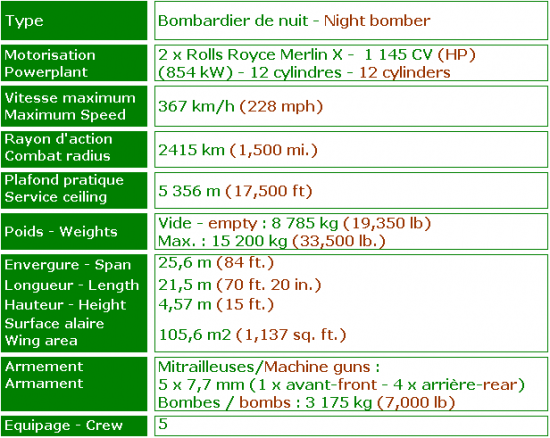Armstrong Whitworth Whitley
Au total, 1 824 Whitley seront fabriqués tous modèles confondus. Les appareils furent livrés à la RAF de Mars 1936 au 6 juin 1943.
1 824 Whitley were manufactured all models together. Aircrafts were delivered to the RAF from March, 1936 to June 6th, 1943.
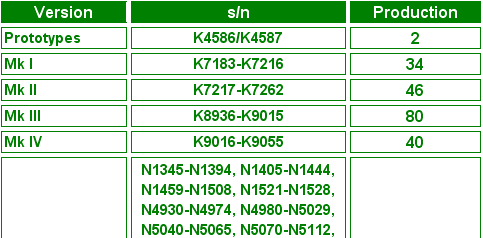
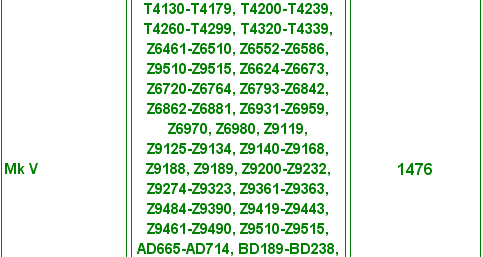
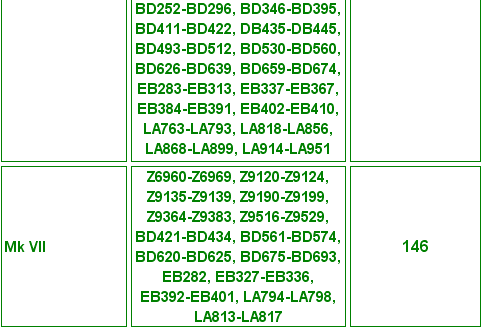
Fiche technique - Technical data
A.W. 38 Whitley Mk V

Armstrong Whitworth Whitley Mk V Z6577 EY-F, 1940 - 78 Sqn
Photo : Source inconnue - Source unknown
Théâtres d'opérations
Operational history
Royal Air Force
Au Bomber Command - In the Bomber Command
Les premiers Whitley Mk I furent livrés le 9 mars 1936 au No 10 Squadron à Dishford, Yorkshire (Angleterre). En janvier 1938, des Mk II furent livrés au n° 58 Squadron, puis des Mk III en août au N° 51 Squadron. Les premiers Whitley Mk IV ne seront livrés qu'en mai 1939 au N° 10 Squadron et des Mk IVA en août de la même année au N° 78 Squadron. Enfin, les Squadrons N° 10 et N° 51 reçurent des Mk V en décembre 1939.
The first Whitley Mk Is were delivered on March 9th, 1936 in No 10 Squadron at Dishford, Yorkshire (England). In January, 1938, Mk IIs were delivered to No 58 Squadron, then Mk IIIs in August to No 51 Squadron. The first Whitley Mk IVs were delivered only in May, 1939 to No 10 Squadron and Mk IVA in August of the same year to No 78 Squadron. Finally, Squadrons No 10 and No 51 received Mk V in December, 1939.

Armstrong Whitworth Whitley Mk I - 10 Sqn
artiste inconnu - artist unknown - source : http://wp.scn.ru
Le 1er septembre 1939, 10 appareils (les K8938 - F/O Milne, K8941 et K8982 du No 51 Sqn et les K8964, 8969, 8973, 8990, 9006, 9013 et un autre appareil du No 58 Sqn) effectuent la première mission de nuit en lâchant des tracts sur Hambourg (Sqn 51), Brême et la Ruhr (Sqn 58). 3 avions du Sqn 58 devront se poser en France victimes de pannes (le K8969 - code GE-G sera détruit sans faire de victimes).
On September 1st, 1939, 10 aircrafts (K8938 - F/O Milne, K8941 and K8982 of No 51 Sqn and K8964, 8969, 8973, 8990, 9006, 9013 and another aircraft of No 58 Sqn) made the first night mission by dropping flyers on Hamburg (Sqn 51), Bremen and the Ruhr (Sqn 58). 3 aircrafts of Sqn 58 had to land in France because of breakdowns (K8969 - code GE-G was destroyed but without any victim).

Armstrong Whitworth Whitley Mk III - 102 Sqn, Driffield
artiste inconnu - artist unknown - source : http://wp.scn.ru
Le 4 septembre, les Sqns 102 et 51 envoient respectivement 3 et 7 Whitley Mk III pour une mission similaire sur la Ruhr. 3 des 7 Whitley du Sqn 51 ne pourront pas redécoller de leur base avancée de Reims à cause de panne et un 4° (K8940) se posera sur une plage vers Cherbourg en panne de carburant.
On September 4th, Sqns 102 and 51 sent respectively 3 and 7 Whitley Mk IIIs for a similar mission on the Ruhr. 3 out of the 7 Whitleys of Sqn 51 could not take off again from their advanced base in Reims because of breakdown and a 4th one (K8940) landed on a beach near Cherbourg out of fuel.
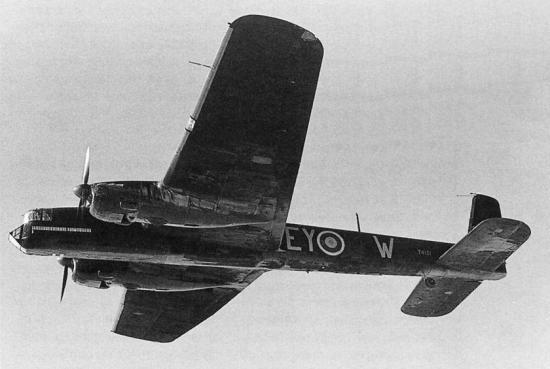
Armstrong Whitworth Whitley Mk V - 78 Sqn
Source inconnue - Source unknown
Le 1er octobre, 3 Mk IV du No 10 Sqn lâchent des tracts sur Berlin. Un 4ème avion (K9018 - F/Lt Allsop) qui devait accomplir cette mission disparaît en mer du Nord : les 5 hommes d'équipages seront les 5 premiers tués du No 4 Group. En décembre 1939 (nuit du 12 au 13), des mines flottantes sont larguées au large de Sylt (Ile allemande en Mer du Nord).
On October 1st, 3 Mk IV of No 10 Sqn dropped flyers over Berlin. A 4th aircraft (K9018 - F/LT Allsop) which also had to achieve this mission disappeared in the North Sea : the 5 crew members were the first persons killed of No. 4 Group. In December, 1939 (the night of 12 and 13), floating mines were dropped over Sylt (German Island in the North Sea).

Armstrong Whitworth Whitley Mk V - 78 Sqn
© Mikhail Bykov - source : http://wp.scn.ru
Début septembre 1939, le No 4 Bomber Group, seul groupe de bombardement de nuit, comptait 6 unités équipées de Whitley (probablement 196 appareils dont 32 Mk I, 43 Mk II, 76 Mk III, 33 Mk IV, 7 Mk IVA et 5 Mk V) :
Early September, 1939, the No. 4 Bomber Group, the only one group of night bombardment, gathered 6 units equipped with Whitleys (probably 196 devices among which 32 Mk I, 43 Mk II, 76 Mk III, 33 Mk IV, 7 Mk IVA and 5 Mk V) :

Basés à Leconfield, les 97 et 166 Squadrons étaient également équipés de Whitley pour la formation des équipages et restaient en réserve. Fin novembre 1939, 24 Whitley (7 du Sqn 10, 8 du Sqn 51, 4 du Sqn 77 et 5 du Sqn 102) sont envoyés en Ecosse à Kinloss après que le Coastal Command ait repéré en mer de Norvège un cuirassé de poche allemand. Ils effectueront des missions de surveillance armées.
Based at Leconfield, No. 97 and 166 Squadrons were also equipped with Whitleys for training the crews which were kept in reserve. Late November, 1939, 24 Whitleys (7 of Sqn 10, 8 of Sqn 51, 4 of Sqn 77 and 5 of Sqn 102) were sent in Scotland at Kinloss after that the Coastal Command located offshore of Norway a German pocket battleship. They made armed missions of surveillance.
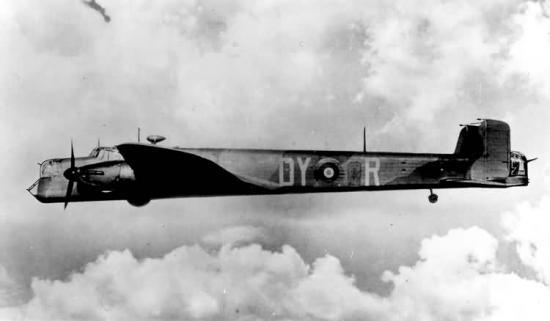
Armstrong Whitworth Whitley Mk V N1380 - No 102 Sqn, Driffield, 04/1940
© Courtoisie - Courtesy Ron Dupas Collection - www.1000aircraftphotos.com
Début 1940, des missions de reconnaissance et d'étude d'objectifs sont effectuées par des Whitley au dessus de l'Allemagne ; le 26 février par exemple, 3 Whitley du Sqn 51 reconnaissent les gares de triage de Rheine, Bielefeld, Bonn et Wesel. En mars, des Whitley Mk V du Sqn 77 larguent des tracts (opération 'Nickel') sur la Pologne. En réaction de l'attaque de Scapa Flow par les Allemands, 30 Whitley des Sqns 10, 51, 77 et 102 bombardent la base aéronavale d'Hörnum (île de Sylt) dans la nuit du 19 au 20 mars. Mais après reconnaissance, l'objectif semble resté intact.
In early 1940, missions of reconnaissance of objectives were made by Whitleys over Germany ; on February 26th for example, 3 Whitleys of Sqn 51 recognizes the marshalling yards of Rheine, Bielefeld, Bonn and Wesel. In March, Whitleys Mk V of Sqn 77 dropped leaflets (operation 'Nickel') over Poland. In reaction to the attack of Scapa Flow by the Germans, 30 Whitleys of Sqns 10, 51, 77 and 102 attacked the naval air base of Hörnum (island of Sylt) during the night of 19th to 20th March. But after a reconnaissance misison, the target semt to be intact.

Armstrong Whitworth Whitley Mk V - 77 Sqn
© John Asmussen - http://www.bismarck-class.dk
Quand les Allemands envahissent la Norvège en avril, 23 Whitleys (Sqns 10, 51, 77, 102) sont envoyés dans la nuit du 11 au 12 bombarder la marine allemande mais sans grand succès. Le 15 avril, des Whitley bombardent également la base de Stavanger. Les missions d'attaque en Norvège et de reconnaissance en Allemagne se succèdent. Le soir de l'attaque allemande à l'ouest, le 10 mai 1940, 9 Whitley partent attaquer les carrefours ferroviaires et routiers du sud des Pays-Bas. Le lendemain, 17 Whithley des Sqns 51, 58, 77 ainsi que 18 Hampden vont bombarder Mönchengladbach. Le Sqn 77 perd l'avion N1366. Le 15 mai, 30 Whitley partent sur divers objectifs mais ne les trouvent pas à cause du brouillard. Le 17, 4 Whitley du Sqn 10 partent en éclaireur et illuminent par des fusées la raffinerie de Brême pour que 15 autres appareils des Sqns 10 et 51 la bombardent. 7 appareils seront endommagés par la DCA.
When the Germans invade Norway in April, 23 Whitleys (Sqns 10, 51, 77, 102) were sent during the night of 11 to 12 to attack the German Navy but without much success. On April 15th, Whitleys also attacked the base of Stavanger. Missions in Norway and Germany continued. In the evening of the German attack in the West, on May 10th, 1940, 9 Whitleys took off to attack the railway and road junctions in Southern Netherlands. The next day, 17 Whithleys of Sqns 51, 58, 77 as well as 18 Hampden attacked Mönchengladbach. Sqn 77 lost the aircraft N1366. On May 15th, 30 Whitleys attacked various targets but did not find them because of the fog. On the 17th, 4 Whitley of Sqn 10 left to find and illuminate the refinery of Bremen so that 15 other aircrafts of Sqns 10 and 51 attack it. 7 aircrafts were damaged by the AA.
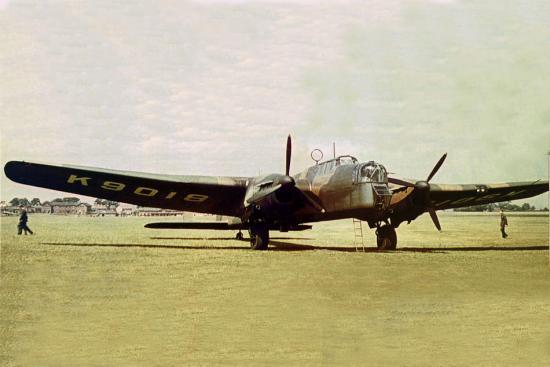
Armstrong Whitworth Whitley Mk IV K9018, Bigin Hill, Sqn 10, 1939
© Courtoisie - Courtesy Etienne du Plessis via "Aeroplane Magazine" - source FlickR
Le 18 mai 1940, le Whitley Mk V N1388 (KN-R) piloté par le F/Lt Raphael est abattu par un Bf 110 C vers Hanovre et doit amerrir. Le mitrailleur de queue, l'AC1 Parkes réussit cependant à abattre le Bf 110 avant la chute. L'équipage sera récupéré par la Royal Navy. Les missions et malheureusement les pertes sont quotidiennes : 2 Whitley du Sqn 102 le 19 mai (N1376 code DY-O, N1417 code DY-B), 2 autres le 20 mai du Sqn 77 (N1384) et du Sqn 102 (N1380 code DY-R), 2 autres encore le 21 mai du Sqn 51 (P4980) et du Sqn 102 (N1528 code DY-E) et un autre encore 2 jours plus tard du Sqn 58 (N1361 code GE-F). 11 Whitley seront perdus sur les 20 premiers jours de la Bataille de France en 350 sorties. Mais le mois de juin sera pire : 5 Whitley perdus sur l'Allemagne du 3 au 11 juin (P4963 code ZA-B du Sqn 10, N1522 code KN-G du Sqn 77, deux autres du Sqn 77 et le P4954 code ZA-T du Sqn 10).
On May 18th, 1940, the Whitley Mk V N1388 (KN-R) flown by F/LT Raphael was shot down by a Bf 110 C around Hanover and had to land on water. The tail-machine gunner, AC1 Parkes could however shoot down the Bf 110 before the fall. The crew was rescued by Royal Navy. The missions and unfortunately the losses happened daily : 2 Whitleys of Sqn 102 on May 19th (N1376 code DY-O, N1417 code DY-B), 2 others on May 20th of Sqn 77 (N1384) and Sqn 102 (N1380 code DY-R), 2 others again on May 21st of Sqn 51 (P4980) and Sqn 102 (N1528 code DY-E) and another one 2 days later of Sqn 58 (N1361 code GE-F). 11 Whitleys were lost on the first 20 days of the Battle of France in 350 sorties. But June was the worse : 5 Whitleys lost over Germany from the 3rd till 11th June (P4963 code ZA-B of Sqn 10, N1522 code KN-G of Sqn 77, two others of Sqn 77 and P4954 code ZA-T of Sqn 10).
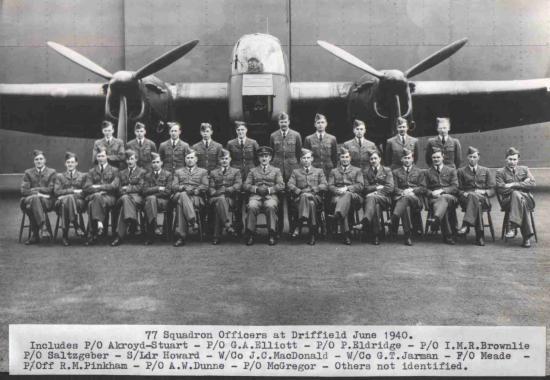
77 Squadron Officers, Driffield, 1940
© Courtoisie - Courtesy of 77 Squadron R.A.F. Association - 77 Sqn RAF
Le 14 juin, des Whitley expérimentent sans succès une nouvelle arme, la mine dérivante W-Bomb sur la Ruhr. 6 autres Whitley seront perdus sur l'Allemagne jusqu'au 25 juin 1940, date de l'armistice : les N1463 (GE-L), N1460 (GE-R), N1442 (GE-N) du Sqn 58, N1499 (DY-M) du Sqn 102, P4960 (ZA-S) du Sqn 10 et N1476 du Sqn 77. Les Whitley continuent néanmoins les missions sur l'Allemagne : ils bombardent les 25 et 30 juin les usines Focke Wulf et le croiseur Scharnhorst le 1er juillet. La chasse de nuit allemande est renforcée et cause des pertes aux Whitley comme par exemple le N1487 (pilote Sgt Monkhouse) abattu le 21 juillet par l'Oberleutnant Streib de la I/NJG 1 près de Münster : ce fut la 1ère victoire nocturne pour Streib mais aussi la première perte face à la chasse de nuit du Sqn 78.
On June 14th, Whitleys experimented unsuccessfully a new weapon, the drifting mine W-Bomb over the Ruhr. 6 other Whitleys were lost over Germany until June 25th, 1940, date of the armistice : N1463 (GE-L), N1460 (GE-R), N1442 (GE-N) of Sqn 58, N1499 (DY-M) of Sqn 102, P4960 (ZA-S) of Sqn 10 and N1476 of Sqn 77. The Whitleys continued nevertheless the missions over Germany : they attacked on June 25th and 30th Focke Wulf factories and cruiser Scharnhorst on July 1st. The German night fight was reinforced and caused losses to Whitleys as for example the N1487 (pilot Sgt Monkhouse) shot down on July 21st by the Oberleutnant Streib of I/NJG 1 near Münster : it was the 1st night victory for Streib but also the first loss caused by the night fight for Sqn 78.
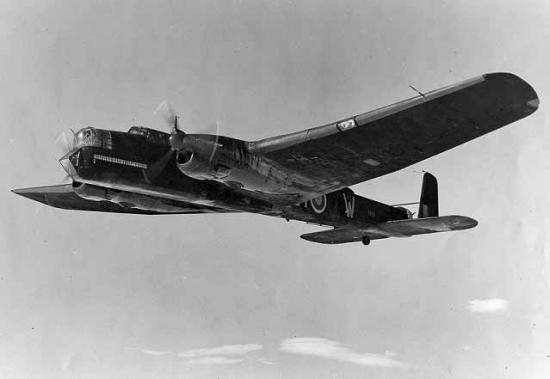
Armstrong Whitworth Whitley Mk V - 'T4131' (EY-W) - 78 Sqn, 1940
Photo : domaine public - Public domain (UK Government)
En août, une mission de représailles est ordonnée par Churchill suite à des bombardements sur diverses villes anglaises : le 25, 81 avions, dont 19 du No. 4 Group, doivent bombarder Berlin. Avec des conditions météo difficiles, seuls 29 semblent y être parvenus, dont 6 Whitley et 27 autres avions larguent leur charge sur d'autres cibles. 5 avions seront abattus mais aucun Whitley. Dans la nuit du 23 au 24 septembre, 24 Whitley (sur 119 bombardiers) participent à un raid sur Berlin ; le P5046 du Sqn 77 amerrira à 100 km des côtes anglaises : 2 membres de l'équipage seront récupérés dans un dinghy 2 jours après mais un seul survivra.
In August, a mission of reprisals is ordered by Churchill after the attacks over different English cities : on the 25th, 81 aircrafts, among which 19 of No. 4 Group, had to attack Berlin. Due to bad weather conditions, only 29 semt to have reached the target, among which 6 Whitleys, and 27 other aircrafts dropped their load on other targets. 5 aircrafts were shot down but no Whitley. During the night from 23rd to 24th September, 24 Whitleys (out of 119 bombers) participated in a raid over Berlin ; the P5046 of Sqn 77 landed in water at 100 km from the English coast : 2 crew members were rescued in a dinghy 2 days later but only one survived.

Armstrong Whitworth Whitley Mk V - 58 Sqn, 1940
© Mikhail Bykov - source : http://wp.scn.ru
Le No. 4 Group est également engagé dans la "guerre des péniches" depuis le mois de septembre : le bombardement des ports abritant des chalands et embarcations depuis le Helder (Hollande) jusqu'à Brest. Des Whitley bombardent ainsi Boulogne, Ostende, Dunkerque, Calais, Anvers, Zeebruges, Le Havre ou Lorient. Un nouveau danger apparaît : le I./NJG 2 dont les Ju 88 C et Do 17 Z attaquent de nuit les terrains du Bomber Command au moment des décollages. Le 20 octobre, 11 Whitley du Sqn 58 décollent pour une attaque sur les usines Skoda de Pilsen. Le T4171 ("GE-O") du P/O Brown est attaqué par le Ju 88 C du Hptm Hulsoff et s'écrase près de Thornaby : l'équipage est tué.
The No. 4 Group was also engaged in the "war of barges" in September : the bombardment of ports with barges and boats from the Helder (Holland) to Brest. Whitleys attacked Boulogne, Ostend, Dunkirk, Calais, Antwerp, Zeebruges, Le Havre or Lorient. A new danger appeared : the I./NJG 2 which Ju 88 C and Do 17 Z attacked at night the Bomber Command airfields during takeoff. On October 20th, 11 Whitleys of Sqn 58 took off for an attack on Skoda factories at Pilsen. The T4171 ("GE-O") of the P/O Brown was attacked by the Ju 88 C of Hptm Hulsoff and crashed near Thornaby : the crew was killed.
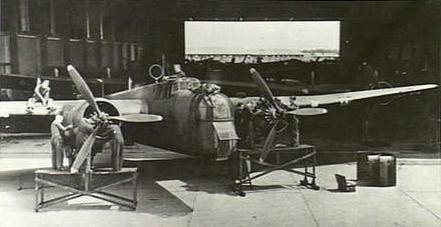
Armstrong Whitworth Whitley - Novembre 1940 - November, 1940
Domaine Public - Public domaine (Picture with courtesy of Australian War Memorial)
A partir de novembre 1940, la stratégie du Bomber Command change pour répondre au bombardement des villes anglaises : les cibles deviennent les industries au coeur des agglomérations allemandes afin de provoquer aussi un sentiment d'insécurité aux civils allemands. Dans la nuit du 16 au 17 décembre, l'opération Abigail Rachel a pour but de bombarder Brême et Mannheim en utilisant la technique allemande de marquage des cibles : 14 Wellington marquent les Motorenwerke-Mannheim avec des bombes incendiaires : puis 103 appareils dont 33 Whitley Mk V bombardent la cible pendant 6 heures. Malheureusement mal marquée, la cible sera peu atteinte.
In November, 1940, the strategy of Bomber Command changed to answer to the bombardment of English cities : targets became the industries in the heart of the German cities to also create a feeling of insecurity to the German civilians. During the night of 16th to 17th December, the operation Abigail Rachel aimed at bombarding Bremen and Mannheim by using the German technique of marking targets: 14 Wellington marked Motorenwerke-Mannheim with incendiary bombs : then 103 aircrafts among which 33 Whitleys Mk V attacked the target during 6 hours. Unfortunately badly identified, the target was poorly reached.
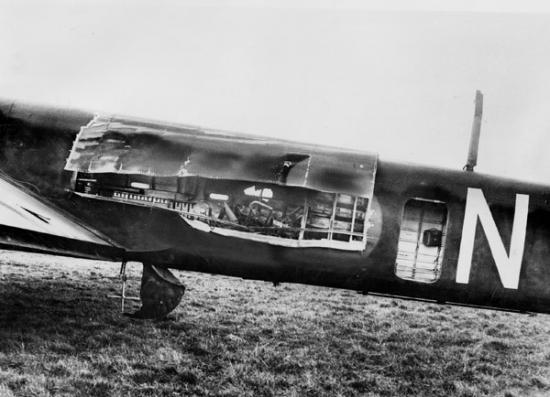
Armstrong Whitworth Whitley Mk V - No. 102 Sqn, 1940 - Linton-on-Ouse
Retour de mission, 13 novembre 1940 - Back from mission, 13 November 1940.
Photo : domaine public - Public domain (UK Government)
En mai 1941, le 4 Group compte 6 Squadrons équipés de Whitley Mk V : les Sqn 10, 51 et 58 à Leeming, Dishford et Linton on Ouse (North Yorkshire), 77 et 102 à Topcliffe (North Yorkshire) et le Sqn 78 à Middleton St George (County Durham). Le 12 juin au soir, 80 Whitley partent pour une mission de bombardement à l'Est de la Ruhr. A cause des conditions météo, 41 seulement bombarderont la cible et 3 ne rentreront pas. Lors du vol aller, le Z6721 du Sqn 10 piloté par le P/O Littlewood doit amerrir suite à des pannes moteurs. 2 Heinkel He 111 survoleront le dinghy où s'est réfugié l'équipage vers 7h du matin : l'un d'eux se met à tourner au dessus du dinghy et l'autre vole vers l'Angleterre puis revient suivi d'une vedette de la RAF qui récupère l'équipage à 7h35. Magnifique (et rare) acte chevaleresque.
In May, 1941, the No. 4 Group accounted 6 Squadrons equipped with Whitleys Mk V : Sqn 10, 51 and 58 at Leeming, Dishford and Linton-on-Ouse (North Yorkshire), 77 and 102 at Topcliffe (North Yorkshire) and Sqn 78 at Middleton St-George (County Durham). On June 12th in the evening, 80 Whitleys left for a mission in the eastern part of the Ruhr. Due to weather conditions, 41 only reached the target and 3 did not return. During the outward flight, the Z6721 of Sqn 10 flown by the P/O Littlewood had to land in the water because of engine breakdowns. 2 Heinkels He 111 flew over the crew's dinghy at about 7 am : one of them kept turning over the dinghy and the other one flew towards England and returned with a RAF rescue boat which rescued the crew at 7:35 am. A great (and rare) chivalrous act.
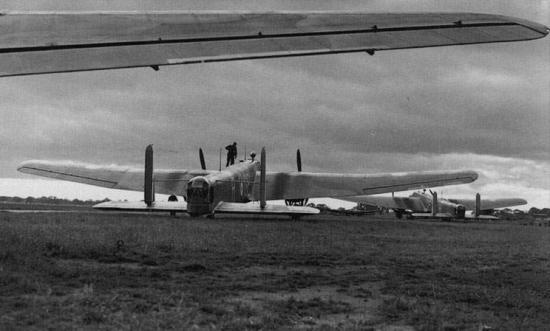
Armstrong Whitworth Whitley Mk V - 58 Sqn, Linton on Ouse, 1940
Source inconnue - Source unknown
Courant juin, les pertes de Whitley sont importantes : le 12, les Mk V T4279 (code "KN-F") du 77 Sqn et Z6489 du 102 Sqn sont abattus. Dans la nuit du 13 au 14, c'est au tour du Z6510 du 102 Sqn. Les 16 et 17 juin, les Z6479 ("MH-H") du 51 Sqn et N1462 ("GE-V") du 58 Sqn sont descendus par des Bf 110 du I./NJG 1 et le Z6492 ("EY-K") du 78 Sqn disparaît. Puis 3 Whitley sont détruits dans la nuit du 18 au 19 juin. En juillet et en août, les pertes continuent comme les 16 et 18 août où 13 Whitley ne rentrent pas de 2 attaques sur les gares de Cologne. De plus, l'efficacité de ces bombardements est très relative : au cours des raids sur la Ruhr, il semble qu'un bombardier sur dix seulement a mis ses bombes à moins de 8 kilomètres de la cible. Le 7 novembre 1941, un raid important sur Berlin verra 37 bombardiers perdus (dont 9 Whitley) sur 397 engagés soit presque 10%.
In June, the losses of Whitleys were important : on the 12th, the Mk V T4279 (code "KN-F") of 77 Sqn and Z6489 of 102 Sqn was shot down. During the night of 13th to 14th, it was the Z6510 of 102 Sqn. On June 16th and 17th, the Z6479 ("MH-H") of 51 Sqn and N1462 ("GE-V") of 58 Sqn were shot down by Bf 110s of I./NJG 1 and the Z6492 ("EY-K") of 78 Sqn disappeared. Then 3 Whitleys were destroyed during the night of 18th to 19th June. In July and August, the losses continued like on August 16th and 18th when 13 Whitleys did not return from 2 attacks on the stations of Köln. Furthermore, the efficiency of these bombardments was very relative : during the raids on the Ruhr, it semt that a bomber out of ten only put its bombs at less than 8 kilometers from the target. On November 7th, 1941, a important raid over Berlin caused the loss of 37 bombers (among which 9 Whitleys) out of 397 engaged i.e. almost 10 %.
Le No 4 Bomber Group le 9 janvier 1942 - The No 4 Bomber Group on the 9th January, 1942 :
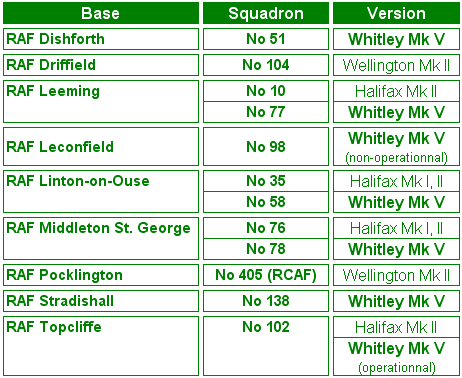 En février 1942, seuls les Sqn 51, 58, 77 et 78 sont encore équipés de Whitley. Dans la nuit du 27 au 28 mars, 37 Whitley des Sqn 51, 58 et 77 soutiennent les commandos sur Saint-Nazaire lors de l'opération Chariot mais avec peu d'efficacité faute d'une bonne visibilité ; les bombardiers Z9274 ("MH-U") et Z9481 ("MH-V") du 51 Sqn et le Z9221 du 77 Sqn s'écrasent au retour à cause du brouillard. En avril, les dernières missions sur Whitley sont effectuées par les Sqn 51 et 77 ; du 23 au 26, 3 avions sont encore perdus : le BD190 ("MH-J") du 51 Sqn et les Z9363 ("KN-H") et Z9386 ("KN-W") du 77 Sqn. Les Whitley du Bomber Command furent retirés du service en avril 1942 après le raid sur Ostende.
En février 1942, seuls les Sqn 51, 58, 77 et 78 sont encore équipés de Whitley. Dans la nuit du 27 au 28 mars, 37 Whitley des Sqn 51, 58 et 77 soutiennent les commandos sur Saint-Nazaire lors de l'opération Chariot mais avec peu d'efficacité faute d'une bonne visibilité ; les bombardiers Z9274 ("MH-U") et Z9481 ("MH-V") du 51 Sqn et le Z9221 du 77 Sqn s'écrasent au retour à cause du brouillard. En avril, les dernières missions sur Whitley sont effectuées par les Sqn 51 et 77 ; du 23 au 26, 3 avions sont encore perdus : le BD190 ("MH-J") du 51 Sqn et les Z9363 ("KN-H") et Z9386 ("KN-W") du 77 Sqn. Les Whitley du Bomber Command furent retirés du service en avril 1942 après le raid sur Ostende.
In February, 1942, only Sqns 51, 58, 77 and 78 were still equipped with Whitleys. During the night of 27th to 28th March, 37 Whitleys of Sqn 51, 58 and 77 supported commandos at Saint-Nazaire during the operation Chariot but without efficiency due to a lack of visibility ; bombers Z9274 ("MH-U") and Z9481 ("MH-V") of 51 Sqn and Z9221 of 77 Sqn crashed on the way back due to the fog. In April, the last missions with Whitleys were made by Sqn 51 and 77 ; from the 23rd to the 26th, 3 aircrafts were still lost : the BD190 ("MH-J") of 51 Sqn and the Z9363 ("KN-H") and Z9386 ("KN-W") of 77 Sqn. The Whitleys of Bomber Command were removed from service in April, 1942 after the raid over Ostend.
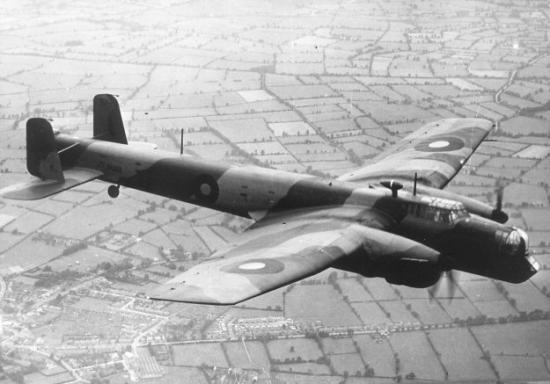
Armstrong Whitworth Whitley Mk V - N1352, 77 Sqn
Perdu en opération sur Trondheim, Norvège le 18 avril 1940.
Lost in operations over Trondheim, Norway on 18 April 1940.
© Ed Coates "www.edcoatescollection.com"
Néanmoins, en mai 1942, le Bomber Command voulant frapper un grand coup avec un raid de 1000 bombardiers sur Cologne, 23 Whitley seront sollicités. Le raid est effectué le 30-31 mai. 1 seul Whitley sera perdu (le Z9307 "H" du Sqn Ldr Russel) et 1 autre (de la 10 OTU) se posera sur le ventre à Manston. Dans la nuit du 1er au 2 juin, nouveau raid de 1000 bombardiers sur Essen : le Whitley Mk V Z6581 ("P") du Sqn Ldr Tomlinson du No 10 OTU est abattu.
Nevertheless, in May, 1942, the Bomber Command wanted to organize a big raid with 1000 bombers over Köln and 23 Whitleys were involved. The raid is operated on 30-31 May. Only 1 Whitley was lost (Z9307 "H" of Sqn Ldr Russel) and another one (of 10 OTU) landed on the belly at Manston. During the night of 1st to 2nd June, new raid of 1000 bombers over Essen : the Whitley Mk V Z6581 ("P") of Sqn Ldr Tomlinson of No. 10 OTU was shot down.
Les Whitley effectuèrent 8 996 opérations et larguèrent 9 845 tonnes de bombes. 269 appareils furent perdus en mission.
The Whitleys made 8 996 operations and dropped 9 845 tons of bombs. 269 aircrafts were lost in mission.
Les unités d'entraînement - Training units
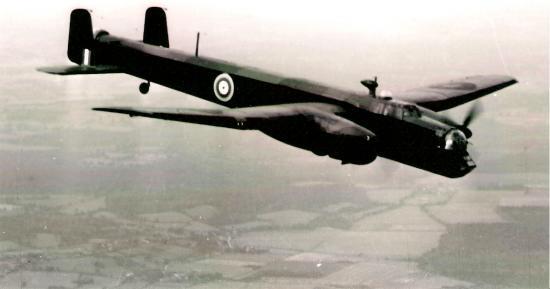
Armstrong Whitworth Whitley Mk V K9025 - 10 O.T.U., Abingdon (Oxfordshire)
© Courtoisie - Courtesy RAF Abingdon 10 OTU - www.rafabingdon10otu.co.uk
Le 8 avril 1940, l'unité d'entraînement No 10 O.T.U. (Operational Training Unit) est formée à partir des Sqns 97 et 166. Equipé de Mk II, III et IV, la 10 OTU est basée à Abingdon (Oxfordshire) et pourra, si nécessaire participer à des missions de combat. Ce sera le cas le 25 juin 1942 pour le grand raid de 1000 avions sur l'Allemagne : 20 Whitley décolleront d'Abington. 1 avion reviendra prématurément et 4 autres s'écraseront (dont 2 avec tout l'équipage tué). En août 1942, un détachement de la 10 OTU sera envoyé à St Eval (Cornouailles) au Coastal Command : 16 455 heures de vol seront effectuées, 55 attaques sur des sous-marins (2 coulés, les U-214 et U-564) et 47 Whitley seront perdus pendant les 11 mois de d'opération.
On April 8th, 1940, the training unit No. 10 O.T.U. (Operational Training Unit) is created from Sqns 97 and 166. Equipped with Mk II, III and IV, the 10 OTU is based at Abingdon (Oxfordshire) and is able, if needed, to participate to operations. It happened on June 25th, 1942 for the great raid of 1000 aircrafts over Germany : 20 Whitley took off from Abington. 1 plane returned prematurely and 4 others crashed (among which 2 had the crew killed). In August, 1942, a section of 10 OTU was sent at St Eval (Cornwall) in the Coastal Command : 16,455 hours of flight were done, 55 attacks on submarines (2 sunk, U-214 and U-564) and 47 Whitley were lost during 11 months of operations.
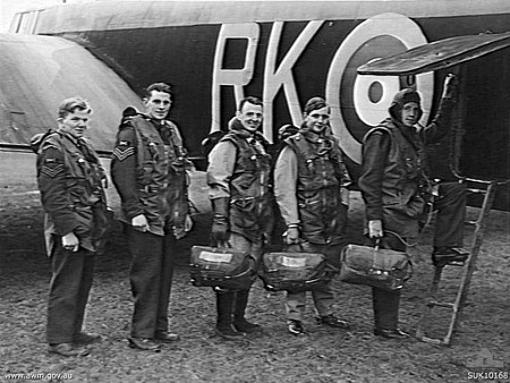
Armstrong Whitworth Whitley - No 10 OTU, 1942
Equipage Australien et Néo-Zélandais (de g. à d.) - Australian and New Zealand crew (L. to R.) :
Sergeant (Sgt) Heyrtley; Sgt M. H. Harwood; Pilot Officer (PO) V. W. J. Mansell; PO M. J. C. Muirhead; PO A. J. Sears.
Domaine Public - Public domaine (Picture with courtesy of Australian War Memorial)
Le 27 mai 1940, la No 19 OTU est formée à la base RAF de Kinloss (nord de l'Ecosse) faisant partie du No 6 Group du Bomber Command pour former des équipages destinés au No 4 Group. La base RAF Forres, proche, accueillit également le 'D' Flight de la 19 OTU en janvier 1941 puis le 'C' Flight en mai. Lors du raid du 25-26 juin 1942, 12 avions de la 19 OTU participèrent au bombardement de Brême (Allemagne) et un équipage ne revint pas (il fut capturé). Ce sera la seule perte de la 19 OTU en action. En 1942, le No 6 Group deviendra le No 91 Group. Les Whitley furent encore utilisés à la 19 OTU même après leur retrait du front.
On May 27th, 1940, No. 19 OTU is formed on the RAF base of Kinloss (Northern Scotland) as a part of No. 6 Group of Bomber Command to train crews intended for No. 4 Group. The close RAF base of Forres also welcomed ' D' Flight of No. 19 OTU in January, 1941 and then 'C' Flight in May. During the raid of June 25-26th, 1942, 12 aircrafts of 19 OTU participated in the attack of Bremen (Germany) and a crew did not return (it was captured). It was the only loss of 19 OTU in action. In 1942, the No. 6 Group became No. 91 Group. Whitleys were still used in 19 OTU even after their withdrawal of the front.
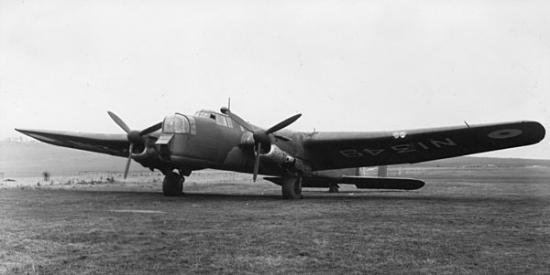
Armstrong Whitworth Whitley Mk V - N1349.
Affecté au 19 OTU (Kinloss), 10 OTU (Abingdon) et 24 OTU (Honeybourne).
Served with 19 OTU (Kinloss), 10 OTU (Abingdon) and 24 OTU (Honeybourne).
Photo : domaine public - Public domain (UK Government)
La No 24 OTU fut également équipée de Whitley (modèles ?). Formée le 15 mars 1942 (No 7 Group puis No 93 Group), elle était basée à la base RAF de Honeybourne (Hereford) pour former des équipages du Commonwealth. Les Wellington remplacèrent les Whitley (date inconnue). La 24 OTU participa à de nombreuses missions comme celle du 25-26 juin 1942 sur Brême (3 Whitley perdus dont le Mk V BD378) ou celle du 31 juillet-1er août 1942 sur Düsseldorf : lors de cette mission, le Whitley Mk V (Z9512) fut abattu (équipage tué sauf le pilote Anthony William Thompson fait prisonnier).
The No. 24 OTU was also equipped with Whitleys (models?). Formed on March 15th, 1942 (No. 7 Group then No. 93 Group), it was based on the RAF base of Honeybourne (Hereford) to train crews of the Commonwealth. The Wellingtons replaced Whitleys (unknown date). The 24 OTU participated in various missions like on June 25-26th, 1942 over Bremen (3 Whitleys lost including the Mk V BD378) or on July 31st-August 1st, 1942 over Düsseldorf : during this mission, Whitley Mk V (Z9512) was shot down (crew killed except the pilot Anthony William Thompson arrested).
L'avion des premières missions - The '1st' missions aircraft
- Première mission de lâcher de tracts le 1er septembre 1939 et première sortie sur Berlin le 1er octobre (voir précédemment - "Au Bomber Command").
- Première mission de bombardement sur le sol Allemand de la seconde guerre mondiale effectuée dans la nuit du 19 au 20 mars 1940 par 26 Withley Mk V des No 10, 51, 77 et 102 Sqns et 20 Handley Page Hampden du No 61 Sqn sur la base d'hydravions de Hornum (nord de l'Allemagne).
- Première mission de bombardement de la RAF sur l'Italie effectuée le 11 juin 1940 sur Turin (usines Fiat) et Gênes (usines Ansaldo) par 26 Withley des No 10, 51, 58, 77 et 102 Sqns partis de Guernesey et Jersey où ils s'étaient ravitaillés. Le N1362 du Sgt Songest s'écrase en flamme au Mans. Des avions feront demi-tour à cause des conditions météo sur les Alpes. Au final, 10 Whitley bombarderont Turin et 2 Gênes.
- Première opération aéroportée en février 1941 (voir plus loin "Opération Colossus").
- Premier sous-marin coulé au sein du Coastal Command sans assistance navale le 30 novembre 1941 (voir plus loin "Au Coastal Command).
- First mission of leaflets dropping on 1st September, 1939 and 1st sortie over Berlin on 1st October (see before "In the Bomber Command").
- First bombing mission over Germany during WWII operated on 19th-20th March, 1940 by 26 Whitleys Mk V of No. 10, 51, 77 and 102 Sqns and 20 Handley Page Hampden of No 61 Sqn over Hornum seaplane base (northern Germany).
- First bombing mission of the RAF over Italy operated on 11th June, 1940 over Torino (Fiat facilities) and Genoa (Ansaldo facilities) by 26 Whitleys of No 10, 51, 58, 77 and 102 Sqns from Guernesy and Jersey where they refuelled. The N1362 of Sgt Songest crashed in flames at Le Mans (France). Some aircrafts had to fly back due to bad wheather conditions over the Alps. Finally, 10 Whitleys bombed Torino and 2 Genoa.
- First airborne mission in February, 1941 (see later "Operation Colossus").
- First U-boat sunk when operating in the Coastal Command without any naval assistance on the 30th November, 1941 (see later "In the Coastal Command").
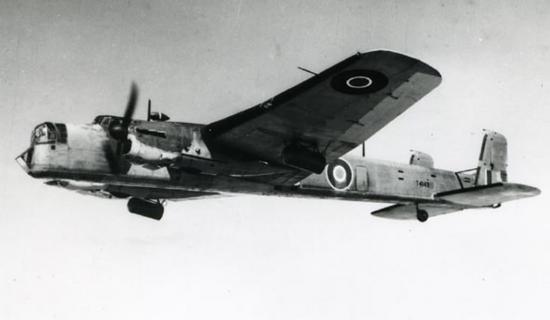
Armstrong Whitworth Whitley Mk V (T4143 ou/or T4149).
Cet appareil fut équipé de fusées d'assistance au décollage.
This aircraft was fitted with rocket pods for take off assistance.
Source inconnue - Source unknown

